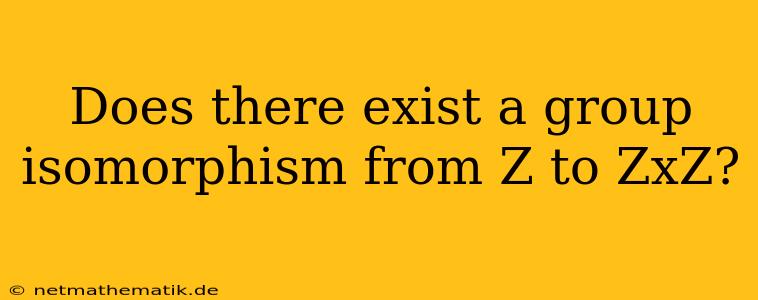The question of whether there exists a group isomorphism from the integers under addition (ℤ) to the direct product of integers under addition (ℤ × ℤ) is a fundamental exploration in abstract algebra. To understand this question, we need to delve into the definitions of group isomorphism and the properties of both ℤ and ℤ × ℤ.
Understanding Group Isomorphism
A group isomorphism is a bijective homomorphism between two groups. This means that it is a function that preserves the group operation. More specifically, a function φ: G → H between two groups (G, *) and (H, ◦) is a group isomorphism if:
- Bijective: φ is both injective (one-to-one) and surjective (onto). This implies that each element in G maps to a unique element in H, and every element in H has a corresponding element in G.
- Homomorphism: φ preserves the group operation, meaning φ(a * b) = φ(a) ◦ φ(b) for all a, b in G.
Properties of ℤ and ℤ × ℤ
- ℤ (Integers under addition): The integers under addition form an infinite cyclic group. This means it can be generated by a single element, in this case, 1. Any integer can be obtained by repeatedly adding or subtracting 1.
- ℤ × ℤ (Direct product of integers): This group consists of ordered pairs of integers (a, b), where the group operation is component-wise addition: (a, b) + (c, d) = (a + c, b + d).
Exploring the Isomorphism
To determine if there exists a group isomorphism between ℤ and ℤ × ℤ, we need to examine the fundamental properties of each group. Let's consider the following:
-
Order of elements: The order of an element in a group is the smallest positive integer n such that the element raised to the power n is equal to the identity element. In ℤ, the order of every element except 0 is infinite. For example, the order of 3 is infinite since 3 + 3 + 3 + ... never equals 0. In ℤ × ℤ, the order of elements is also generally infinite, except for the identity element (0, 0).
-
Cyclic structure: ℤ is cyclic, meaning it can be generated by a single element. However, ℤ × ℤ is not cyclic. There is no single element in ℤ × ℤ that can generate all other elements. For example, (1, 0) generates all elements of the form (n, 0), but it cannot generate (0, 1).
Based on these properties, we can conclude that no isomorphism exists between ℤ and ℤ × ℤ.
Here's why:
-
Order of elements: Any isomorphism must preserve the order of elements. Since ℤ has elements of infinite order, any corresponding element in ℤ × ℤ must also have infinite order. However, ℤ × ℤ contains elements with finite order, such as (1, -1) whose order is 2. This discrepancy in the order of elements prevents a bijective homomorphism.
-
Cyclic structure: A cyclic group can only be isomorphic to another cyclic group. Since ℤ is cyclic and ℤ × ℤ is not, no isomorphism can exist.
In summary, the fundamental difference in cyclic structure and the existence of elements with finite order in ℤ × ℤ while ℤ only has elements with infinite order (except for the identity) preclude the possibility of a group isomorphism between ℤ and ℤ × ℤ.
Alternative Perspectives
While a direct group isomorphism may not exist, it is important to note that:
- Ring isomorphism: There exists a ring isomorphism between ℤ and ℤ × ℤ. A ring isomorphism preserves both addition and multiplication, which is a stronger condition than a group isomorphism.
- Subgroup isomorphism: We can find specific subgroups of ℤ × ℤ that are isomorphic to ℤ. For example, the subgroup consisting of all elements of the form (n, 0) is isomorphic to ℤ.
Conclusion
The exploration of whether there exists a group isomorphism from ℤ to ℤ × ℤ highlights the crucial role of group structure in determining isomorphisms. The differences in cyclic structure and order of elements between these groups make such an isomorphism impossible. However, the concept of ring isomorphism and the existence of isomorphic subgroups within ℤ × ℤ demonstrate that even in cases where a direct isomorphism is not possible, connections can still exist between groups. Understanding these connections provides valuable insights into the richness and complexity of abstract algebra.
